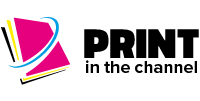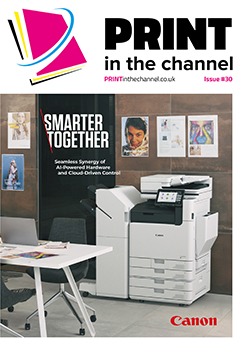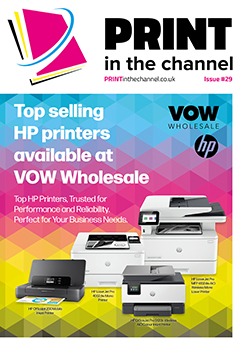As data becomes more and more valuable to businesses, Print Management Software offers a solution to efficiency, security, and cost reduction.
Printing has been an essential business practice for decades, and it still plays a crucial role in today’s workplaces.
In my own time as a hack, the printer has never stopped as I see how articles look on the page, make corrections, and sift through lengthy transcriptions of my latest interview.
However, a lack of control and process in print can lead to increased costs, waste, and security risks. To address these challenges, businesses are turning to print management software, which enables rules-based printing and quotas that can be easily rolled out across an organisation, enhancing control while reducing waste and costs.
“Print management software can help businesses achieve greater efficiency, enhanced security, better sustainability, and streamlined printing processes,” said Fawaz Naser CEO Softlist.io.
“By providing tools to monitor and manage print jobs, control access to printers, and encourage responsible printing practices, print management software can help organisations reduce costs, improve security, and demonstrate their commitment to sustainability.”
“Printing is a fundamental business practice that still has a place in the workplace today,” said George Davies, Product Marketing Manager of Software and Solutions at Sharp UK. “But a lack of control and process in this area can lead to increased costs, waste and can even be a security risk. This is where the often-overlooked solution of print management software comes in.
“Print management software enables the implementation of rules-based printing and quotas which can be easily rolled out across an organisation, enhancing control whilst also reducing waste and cost. This, for example, can include default mono-duplex printing, whereby the auto settings for print jobs are mono and double-sided.”
Automation
With that control comes an opportunity, especially in this data-heavy age. Being able to automate tasks is a huge trend throughout the technology industry; to the point where even my job can be done by a robot apparently.
This automation wrapped in a print management software solution, according to Ian Silvester, director of product management and customer care at EKM, will be able to save end users time and money and change the way reports are handled.
“It’s all about efficiency, security, cost reduction, accuracy, reliability, for resellers because the more you can automate through software, in terms of your business requirements, the more profit you will make.
“For instance, to get a printer metre reading for a fleet of printers we’d have to individually call hundreds of customers and ask for it. When you automate that to software, it obviously reduces the effort it takes to do that from a reseller end. From the customer perspective, when you’re looking at the end users, using print queue management software allows them to track who’s printing, what they’ve been printing, where they printed it and massively reduce wastage.”
In time gone by, one of the key selling points for print management software was the control that could be imposed with its use, as Steve Peace, group head of marketing at Kyocera pointed out.
“I think the biggest difference really is that in the past the key USP of this software was to stop people printing, limit the amount of pages people can print, and stop printing in colour. Ironically we’re now trying to offer a gateway to enable print.
“The total cost of ownership for printing has never been cheaper, so the focus has moved on to energy saving, and power management. I think data is a big thing, if resellers are clever with the data, they can prove where their customers gain value from their products.
“Moving forward, rather than stopping people from printing, the data should be used to understand how users are printing, how secure is the print? Is there a copy left on the device? As security becomes more important, businesses will be able to detect whether there are any GDPR implications, turning secure printing into a USP.”
“With this automation, resellers will be saving customers an awful lot of time,” said Silvester. “But also they will be improving their customer satisfaction with these efficiencies.
“If resellers set up consumable replenishment using a just in time method, they’ll never gonna run out of stock. With the traditional method, as soon as that light comes on, they’ll have to ring up to restock and potentially have to wait around for the consumables to turn up before they can resume.
“With automated print management software, resellers can supply consumables just in time. That works for both parties because the customer will have minimal disruption, and resellers don’t send their working capital out too early.”
To the Cloud
The drive for data has, in many ways, been synonymous with the increase in Cloud technologies; one of the more pressing issues in the print market.
Cloud adoption is driving the modernisation of print infrastructure, and cloud-based print management software is currently in high demand, as Davies says: “This demand aligns with the general shift of businesses moving their data and applications away from traditional on- premise servers to the cloud.
“We are seeing heightened awareness and understanding of the benefits of shifting to cloud-based print. These include easier administration, enhanced security, better alignment with broader company cloud-first policies and, of course, reduced costs. If customers don’t have a cloud print solution now, they are certainly looking for one.”
Cloud-based print management software can offer greater flexibility, scalability, and cost-effectiveness than traditional on-premise solutions. Businesses can manage their printing activities from anywhere, using any device with an internet connection. This feature is particularly useful in today’s remote work environment, where employees need to access company resources from anywhere.
Remote working is a point Naser picked up on, adding that “with the rise of remote work and bring-your-own-device (BYOD) policies, mobile printing has become increasingly important.”
Pearce agreed, adding that resellers needed to be clear on whether they were offering a cloud native or a premise-based solution.
“The important thing is having the flexibility to offer a cloud native product, but also understand the benefits and the pros and cons of hosting a once premise based product in the cloud environment.
“Broadly speaking, I think the biggest change I’ve seen in the last a period has been the desire for our end users to have a cloud hosted version. Probably boosted by COVID, we’ve seen a real acceptance of the benefits of a cloud hosted offering, and these are SaaS-based propositions, and I think we’ve seen the print management software naturally fall into a cloud offering.
“When we talk about ‘aaS’ the print industry has been doing that for a long time. The natural way for resellers to go on to sell software is as a service, and cloud is the vehicle to do that and, frankly, it’s what our customers are asking for.”
Selling Software
With an appetite for cloud services and a distributed workforce, software that helps businesses have sight of how these solutions are being used sounds like an easy sale.
Davies said that “context is key”, with Naser adding that resellers should be open to a conversation with customers before forcing solutions on them.
“Resellers should follow a consultative sales approach when selling print management software to customers,” said Naser.
“This involves understanding the customer’s needs and pain points, identifying the features and benefits of the software that address those needs, and presenting a tailored solution that meets the customer’s specific requirements.”
But those requirements are ever changing. As Pearce points out, one of the key benefits of cloud technology is that it is “scalable”. That always has connotations with getting bigger, but working habits change.
“By having a cloud based system where you can simply bolt devices on, or bolt users on, and take them off, rather than buying these cumbersome upfront contracts is definitely the way that I would go.”
With chat of bolt ons, Silvester also said that he sees print becoming amalgamated with other consumables purchasers need, such as coffee, adding that, with the use of print management software, print can be one of the less demanding utilities in the office.
“IT departments see print as a necessary evil. They want to have a printer, press a button and it to just work.
“In order to do that, we can use data to save time and prevent problems before they arise. We used to do preventative maintenance on all equipment, where if we’d send somebody out to fix a machine, that engineer would also look at all the machines in that location and if some of them needed preemptive maintenance, we do that as well.
“That increases the mean time between engineer visits, and then that data is reported back to the print software where they can measure the time between fixes on devices with engineers.”









